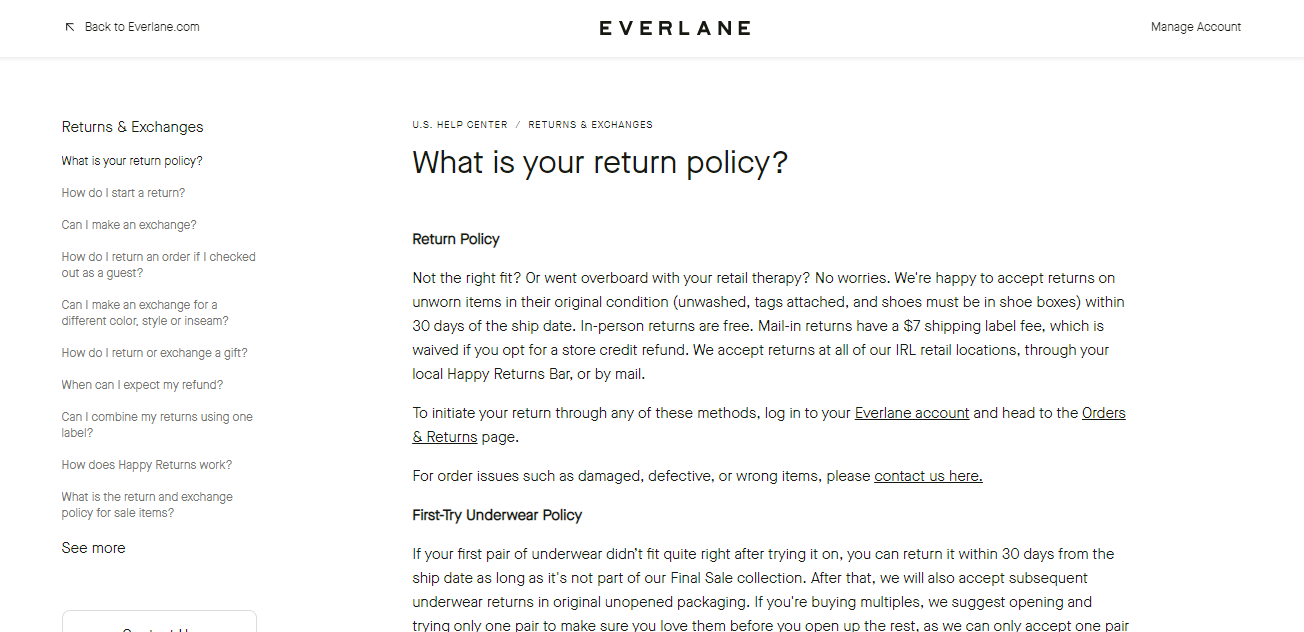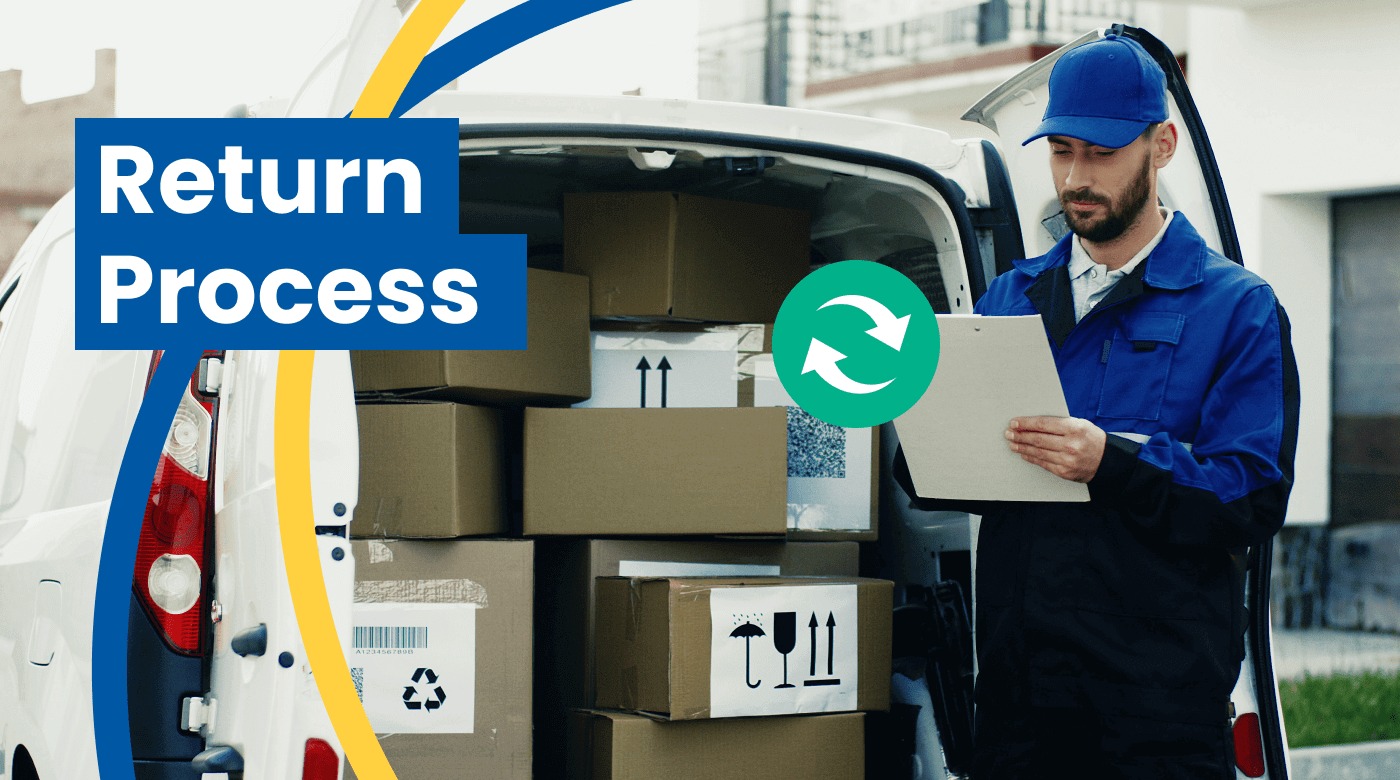It’s no longer enough for e-commerce and retail businesses to provide an average return experience.
Amazon and Zappos have set the bar so high that returning an item has moved from a mundane hassle to a seamless experience, and your return process can’t afford to be any different.
Beyond actively seeking ways to add convenience that dazzles your customers, there’s another business case for improving your returns process: you can simultaneously optimize the handling of returned merchandise to increase sustainability and reduce costs. Retail returns are expected to hit $627.34 billion in 2023.
In this article, we'll delve into the realm of returns and explore four essential pillars that pave the way to a streamlined and efficient returns system.
1. Streamline your returns policy
You buy something online, but it isn’t quite what you expect. So, you visit the website to find return information and are met with a convoluted returns policy buried in lengthy terms and conditions that no one ever reads.
You struggle to navigate the cumbersome process, print your own shipping label, and ship the item back to the seller. Then you wonder about the status of your refund. Are you ever going to see your money again, or is it gone?
You can likely empathize with customers around the world who have had to deal with similarly cumbersome returns processes. And now, you don’t want your customers to have to face the same situation.
So, what’s the solution?
Here are four tips to streamline your returns policy to improve the overall experience for your customers:
Tip #1: Simplify the returns process by offering prepaid return labels
One major friction point in the returns process for many retailers is the burden they place on customers to print their own return shipping labels. By including prepaid shipping labels in packages you send to your customers, you save them the hassle of finding a printer, wasting paper, and covering the return shipping costs themselves.
But that’s not all. You also save yourself a lot of headaches.
You’ll know exactly how much the return shipment will cost you, how long the package will take to reach you, and which carrier they’ll use, and you can even track the package all the way to its destination. That’s a huge return on such a small expense.
Tip #2: Implement an online returns portal for easy submission and tracking
There are several benefits to creating an online returns portal. But the most important is that it serves as a centralized hub where your customers can easily submit and track their returns in real time without needing any assistance from your customer support team.
That also means cost savings for you since it reduces the load on your customer service team, freeing them up to focus on dealing with more complex issues.
Tip #3: Apply automation and technology to expedite return handling
Finally, you can leverage automation and technology to implement intelligent systems that can automatically process return requests, assess product condition, and initiate timely refunds or replacements as needed.
This will allow you to speed up the return handling process and improve efficiency since it reduces the amount of manual intervention involved.

Everlane is a perfect example of a streamlined returns process in action. It offers free in-person returns within 30 days of purchase, and customers can return their items using a prepaid return label that they can print from their account or request from customer service.
It also has an online returns portal where customers can select the items they want to return, choose a refund method, and track their return status. Plus, it uses automation and technology to process the returns and issue the refunds within 5 to 10 business days.

2. Optimize your communication channels
Customers crave instant updates and seamless interactions with brands. Just ask the 72% of customers who expect to engage with someone immediately when they contact a company.
As such, there’s a lot of untapped potential in your communication channels, and you can use them more efficiently to build trust, enhance transparency, and create an overall delightful return process.
Here are five tips to help you apply this to your business:
Tip #1: Be forthright and upfront about the return process
It’s okay if you can’t offer the same return policies that mega brands like Amazon and Zappos offer. But whatever your return policy is, it helps to be upfront about what customers should expect before they make a purchase — not after something goes wrong.
That’s because it’s vital to manage expectations. If you don’t take control upfront and direct customer expectations, it’ll be difficult to impress anyone who expects more than you can provide.
So, let customers know the time frame within which you’ll accept returns. Mention any specific conditions or requirements you might have. Don’t hide associated costs.
And most of all, don’t bury this information in the fine print or make it difficult to find.
Tip #2: Offer multiple channels for customers to initiate returns
Everyone has preferences and comfort levels when it comes to technology. Therefore, you should provide a diverse range of channels for initiating returns.
Aside from phone and email, also include options like web forms, chatbots, and even mobile apps to accommodate more customer preferences. That’ll foster a greater sense of control and convenience in customers.

Tip #3: Provide regular updates on the status of returns
Nothing is more effective at sowing discontent in customers than a lack of visibility into the progress of their returns. That's why you must keep your customers in the loop at every stage of the process with prompt and regular updates.
Whether it’s an email notification to confirm that you’ve received the return request, a notification to update them with the results of an inspection, or a real-time tracking feature, these updates are uber-effective when it comes to demonstrating transparency and instilling confidence in the returns process.
Think of how a progress bar during a software installation creates a sense of anticipation and assurance in you. That’s how customers feel when you keep them abreast.

One example of a brand that has optimized its communication channels for returns is L.L.Bean.
It offers multiple channels for customers to initiate returns, allowing buyers to process returns and exchanges through UPS or US mail as well as through one of their retail stores at no extra cost. Customer support is on hand at any time to help with any questions you might have about the returns process too.
3. Enhance product packaging and documentation
It might not seem like it at face value, but product packaging and documentation also play a vital role in the returns process. While they may not directly dictate the return itself, you shouldn’t underestimate their impact.
Consider that one of the top three reasons people returned an item was because it was either damaged or defective — with 65% of consumers agreeing to this.
If you have a return rate of 16.5% (which is the industry benchmark for e-commerce in 2022) and can eliminate returns due to damage — hypothetically speaking — you could potentially cut your return rate to 5.8%. Not too shabby for an “indirect” impact.
Let’s now explore four ways to apply this to your business and transform your product packaging and documentation from afterthoughts to invaluable assets.
Tip #1: Use sturdy packaging materials to prevent damage during transit
Sturdy packaging materials will safeguard your products against the perils that could befall them in transit.
Use reinforced boxes. Incorporate protective layers into your packaging. Consider adopting customized packaging solutions that account for the peculiarities of your products in their design.
Doing these will increase the likelihood that your products will arrive at the customer’s doorstep in pristine condition and lessen the chances of returns due to damage.
What’s more, if a customer does return a product for any other reason, these measures will also ensure that items returned in good condition don’t arrive at the receiving warehouse in bad shape.

Tip #2: Include clear instructions and troubleshooting guides with the product
There are few things more frustrating than receiving a product without clear instructions for using or troubleshooting it. So, it pays to include comprehensive and user-friendly instructions for the setup, operation, and maintenance of your products.
Troubleshooting guides are also vital for reducing returns altogether and lessening the burden on your customer support team since they empower your customers to address common issues on their own.
Tip #3: Provide comprehensive product information and specifications
Information is power, and a well-informed customer is a satisfied customer. One powerful way to reduce returns is to include detailed product information and specifications within your packaging.
This applies to everything from information about product dimensions and technical specifications to care instructions and warranty details. By ensuring that customers have all the necessary information at their fingertips, you empower them to make informed decisions and reduce the odds of returns caused by mismatched expectations.
One brand that nails product packaging and documentation is Blueland, which sells eco-friendly cleaning products.
It uses sturdy packaging materials such as glass bottles and compostable paper to prevent damage and reduce waste. There are clear instructions and troubleshooting guides with all its products, such as how to use the refill tablets, how to clean the bottles, and how to contact customer service.
Blueland also provides comprehensive product information and specifications on its website and packaging labels, such as each product’s ingredients, benefits, certifications, and usage tips.
4. Implement a robust quality control process
It’s easy for your quality control process to get lost in the shuffle of managing a retail or e-commerce business day to day. But it can be detrimental to underestimate the significance of a robust QC process for retail returns.
Not only does implementing a rigorous QC process ensure that returned items are properly assessed and handled, but it also presents a wonderful opportunity to identify areas with room for improvement across the board.
Here are four tips to help you pay greater attention to this often-neglected aspect of retail returns:
Tip #1: Conduct thorough inspections of returned items
It’s vital to conduct thorough inspections of returned items to accurately determine the validity of the return.
The point is to carefully examine the condition of the product and check for any damage, missing parts, or signs of wear and tear to glean any information that might be useful in determining what the appropriate next step should be.
This will ensure that only genuine returns are processed and reduce the chances of unwittingly reselling damaged or faulty items to unsuspecting customers. In this way, a robust QC process protects your brand reputation.

Tip #2: Categorize returns based on condition and reason
Another key element of a robust QC process is categorizing returns according to the condition and reason for the return — such as sizing issues, product defects, or inaccurate descriptions.
Doing this makes it easier to recognize trends and spot common issues associated with your returns. And that, in turn, allows you to proactively address these issues, thereby mitigating your return rates in the long run.
Tip #3: Determine if items can be refurbished or resold
In addition to assessing the condition of returned items, you should also evaluate whether they can be resold or refurbished before condemning them to the nearest landfill. This can be a cost-effective solution to the impact of returns on your bottom line.
Of course, this depends on the nature of your business and the product in question. For instance, lightly used clothing and electronics are prime candidates for refurbishing and reselling, but not quite so for food items.
Besides minimizing your losses due to returns, refurbishing and reselling suitable products also allows you to optimize your inventory and reduce waste, which can be a huge boost to your brand if you’re big on sustainability.

How to improve your returns process: the bottom line
In the end, improving your returns process comes down to focusing on the customer. And you can build a customer-centric return process by implementing these four tips.
DeliverySolutions puts an omnichannel footprint at the fingertips of enterprise, retail, and e-commerce brands, giving you access to a multi-provider logistics network on a single platform. This allows you to offer multiple delivery options, thereby enriching the delivery experience for your customers.
Schedule a demo today to learn how it works.
Caitlyn Metzker
Caitlyn Metzker, a professional with 9 years of experience, brings a wealth of insight to her Sr. Enterprise Account Executive role. As a University of South Carolina graduate, Caitlyn has honed her skills within the industry previously with Roadie and Kabbage. Originating from Philadelphia, her multifaceted interests include traveling, hiking, soccer, swimming, and boating, reflecting her adventurous spirit. Her favorite getaway is the picturesque Kauai, Hawaii. Caitlyn's business philosophy underscores the importance of continuous learning, as she believes that "there is always more to learn; absorb as much as you can." When not devising groundbreaking strategies, Caitlyn unwinds by delving into books or enjoying the serene beach. Adding a unique touch, she cherishes the privilege of occasionally working alongside her sister and mother as part of the UPS Digital family. Caitlyn's profound industry knowledge and passion make her an invaluable asset to our B2B SaaS sales and marketing team.
Topics from this blog: Delivery Efficiency Ecommerce
